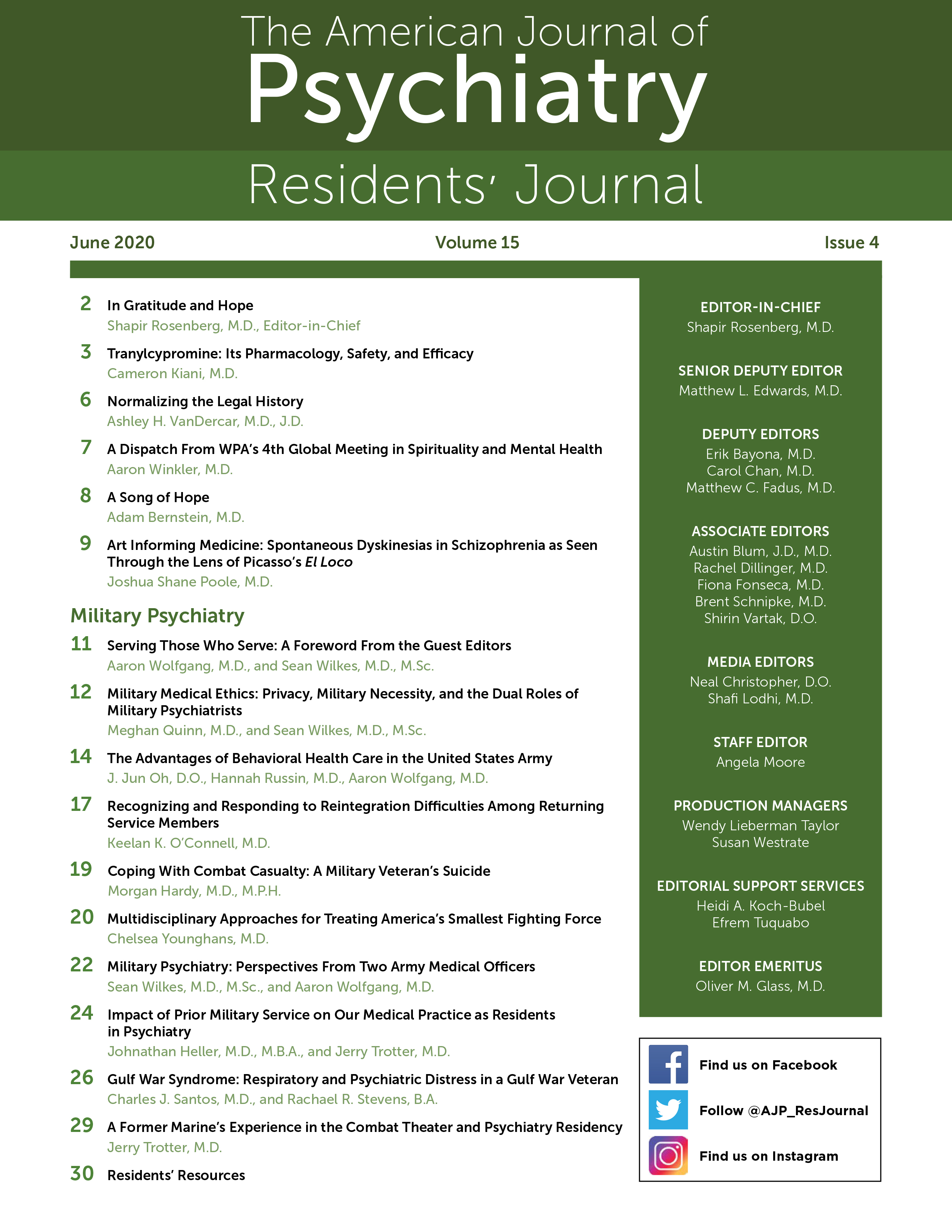Through its active role in the War on Terrorism, the United States is embroiled in the longest period of continuous war in U.S. history (2001–present), placing a tremendous physical and psychological toll on 1.3 million active duty service members, 800,000 reservists, and 20.4 million U.S. military veterans (
1,
2). Although much attention has been placed on diagnosing and treating posttraumatic stress disorder, depression, anxiety, and suicidality in military service members returning from deployment, symptoms of difficulty with reintegration, estimated to affect 54% of returning service members, are often less commonly recognized or addressed by health care providers (
3).
An extensive 2017 analysis conceptualized postdeployment reintegration as both a process and an outcome of resuming roles and responsibilities in family, community, and workplace (
4). The feelings and behaviors accompanying reintegration exist along a continuum of mild, less distressing symptoms to more severe, pathological symptoms requiring clinical intervention. Similar to adjustment disorder, reintegration difficulties are characterized by changes in mood and behavior in response to a significant life change. Notably, whereas adjustment disorder may manifest with depressed or anxious mood or worry, common symptoms of reintegration difficulty include feelings of restlessness, boredom, frustration, and emptiness that often stem from returning to slower-paced and seemingly less meaningful work and home environments (
4). Many service members also report chronic fatigue due to an inability or unwillingness to fully relax in public or private settings, preferring instead to remain always alert. Other prevailing reintegration symptoms include feeling misunderstood, unrecognized, isolated, and changed—as though one's mindset, behaviors, and attitudes have shifted (
5). Service members may also experience deterioration in psychosocial domains, such as interpersonal relationships or career progression. These symptoms may occur regardless of one's role while deployed or whether or not one engaged in combat.
The DSM-5 does not recognize "reintegration syndrome" (or any such derivative) as a diagnostic entity, and no universal diagnostic criteria or universal treatment algorithm exists. It is also not well understood who is at risk of developing symptoms of reintegration difficulty. Because of its prevalence, pathology, and potential for treatment, "reintegration syndrome" should be considered as a distinct diagnostic entity or as a subtype of adjustment disorder in future DSM iterations.
Despite the challenges described above, health care providers should not feel powerless in assessing and treating individuals struggling with reintegration. Every military and civilian provider, regardless of specialty or setting, has a responsibility to be aware of the potential implications that deployment may have on quality of life, regardless of whether a patient meets diagnostic criteria for a DSM-5 disorder. A helpful way to initiate a patient discussion might include the following: "In what ways (both good and bad) have things changed for you since returning from deployment? Tell me more about your experience returning to your family, work, and community. Do you have any thoughts, behaviors, actions, or responses to situations that are bothersome or frustrating to you?"
Facilitating such a discussion can help providers better understand patients with these difficulties and offer them help, such as reassurance during their encounter, referral to a support group, medication for a recognized co-occurring behavioral health condition, or behavioral interventions such as thought restructuring or resilience-building techniques. Because of the tendency toward isolation and feelings of being misunderstood in those struggling with reintegration, it is recommended that all treatments encourage and facilitate peer connections and social support (
5).
In summary, reintegration difficulties have signs and symptoms similar to but different from accepted those of DSM-5 diagnoses. Providers should strive to ask appropriately targeted questions and offer treatment catered to patient needs while ongoing research further elucidates how best to diagnose and treat this often underrecognized condition.
